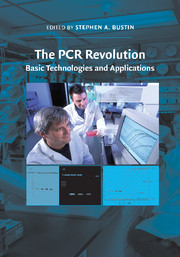Book contents
- Frontmatter
- Contents
- Contributors
- Foreword by Russell Higuchi
- Preface
- I BASIC TECHNOLOGIES
- II APPLICATIONS
- 10 Polymerase chain reaction–based methods for the detection of solid tumor cancer cells for clinical diagnostic and prognostic assays
- 11 Polymerase chain reaction and infectious diseases
- 12 Polymerase chain reaction and respiratory viruses
- 13 Polymerase chain reaction and severe acute respiratory syndrome
- 14 The MMR vaccine, measles virus, and autism – A cautionary tale
- 15 Noninvasive prenatal diagnosis using cell-free fetal nucleic acids in maternal plasma
- 16 Polymerase chain reaction–based analyses of nucleic acids from archival material
- 17 Microarrays and quantitative real-time reverse transcriptase–polymerase chain reaction
- 18 Polymerase chain reaction in the detection of genetic variation
- 19 Polymerase chain reaction: A blessing and a curse for ancient deoxyribonucleic acid research
- Index
- Plate section
- References
10 - Polymerase chain reaction–based methods for the detection of solid tumor cancer cells for clinical diagnostic and prognostic assays
Published online by Cambridge University Press: 25 January 2011
- Frontmatter
- Contents
- Contributors
- Foreword by Russell Higuchi
- Preface
- I BASIC TECHNOLOGIES
- II APPLICATIONS
- 10 Polymerase chain reaction–based methods for the detection of solid tumor cancer cells for clinical diagnostic and prognostic assays
- 11 Polymerase chain reaction and infectious diseases
- 12 Polymerase chain reaction and respiratory viruses
- 13 Polymerase chain reaction and severe acute respiratory syndrome
- 14 The MMR vaccine, measles virus, and autism – A cautionary tale
- 15 Noninvasive prenatal diagnosis using cell-free fetal nucleic acids in maternal plasma
- 16 Polymerase chain reaction–based analyses of nucleic acids from archival material
- 17 Microarrays and quantitative real-time reverse transcriptase–polymerase chain reaction
- 18 Polymerase chain reaction in the detection of genetic variation
- 19 Polymerase chain reaction: A blessing and a curse for ancient deoxyribonucleic acid research
- Index
- Plate section
- References
Summary
The biological process of metastases requires multiple individual steps to successfully establish a solid tumor at a secondary site. Tumor cell(s) need to migrate through and from the primary tumor mass, intravasate into and survive within the hemopoietic or lymphatic vascular systems, extravasate from these systems into secondary tissues and initiate proliferation and angiogenesis. Multiple molecular and microenvironment factors influence these processes, defining which tumor cells survive, spread to distant organs and give rise to metastases. Despite considerable advances in the treatment of solid cancers, metastases remain the major clinical challenge for successful treatment. The classic view is that metastatic spread is a late process in disease progression. However, the prognosis for patients with small or even undetectable primary tumors is still limited by metastatic relapse, sometimes long after removal of the primary tumor. This has led to the hypothesis that primary tumors may shed tumor cells at an early stage, resulting in the dissemination of tumor cells to distant sites and development of metastases. Interestingly the bone marrow (BM) and lymph nodes (LN) seem to be common homing tissues for many different disseminating tumor cells, and so the early detection and characterization of tumor cells in these compartments could help guide treatment decisions before the onset of overt metastases, as well as in the setting of advanced disease. Unfortunately the number of tumor cells in these sites is usually small and they are not detected using current technologies.
- Type
- Chapter
- Information
- The PCR RevolutionBasic Technologies and Applications, pp. 155 - 172Publisher: Cambridge University PressPrint publication year: 2009



